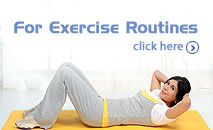
A working man or woman, on an average, spends anything from 25 to 40 hours a week in a static position. Even commuting can involve long journeys with little scope for movement. At home, it is far easier to sit sprawled on the sofa or to eat dinner slouched in front of the TV, than it is to make sure that the spine is correctly aligned so that there is no strain on the back.
Sitting or standing for long periods of time, improper posture, stress and lack of exercise are the most common causes of back pain.
Correct posture is crucial to prevention of injury in everyday life. Good posture benefits health by allowing the internal organs to function more efficiently and the muscles to work efficiently and safely. Poor posture on the other hand, leads to joint strains and is the prime cause of severe back problems.
Always check your posture to ensure that you sit, stand and walk correctly.
The shoulders should be level, back and down, the chest open and chin in. If you are standing, the knees and hips should be straight and the pelvis in a neutral position.
Most postural problems can be remedied easily with a little conscious practice in standing and sitting correctly. But the first step is to identify your posture habits.
Stand face on the mirror and answer the following questions:
- Are your shoulders level?
- Are your hips level?
- Are your knees level?
- Are your feet turned in or out?
Now stand sideways facing the mirror and answer the following questions:
- Does your chin jut out?
- Are your shoulders hunched?
- Is your back arched?
- Does your stomach stick out?
If you have identified an alignment problem, try to rectify it by correcting your posture and standing upright. If you have serious postural problems, you may need to consult an osteopath or a physiotherapist for advice on remedial exercises.
Here are some back-friendly practices to prevent or relieve fatigue and strain:
-
Pay attention to the “natural curves” of the spine. They should always be aligned.
-
Adjust your chair height so that your arms are at desk level and your weight is shifted forward off your spine.
-
Don’t stick your neck out -- literally. Your head weighs about 15 pounds. Keep it balanced over your neck and spare your neck and shoulders.
-
Change your position throughout the day to keep your muscles from tensing. Be sure your spine stays aligned.
-
Keep your feet flat on the floor or on a footrest to help maintain a good sitting posture and aid circulation.
-
Use the backrest of your chair to support your lower back.
-
Sit squarely in front of a computer terminal. Avoid twisting to the side if you are working from a book or side table. Your neck, upper back, and lower back should be aligned.
-
Relax. Let your shoulders and neck muscles go limp. Lower your head and let it droop all the way forward.
-
Stretch. Clasp your hands behind your head and bring your elbows back. Then bend forward until your back is horizontal.
-
The distance between you and the monitor should be 18 to 30 inches, or about an arm’s length.
-
When you lift objects, do so safely. Squat down – straddle the load a little. Keep your back straight and bend your knees. Raise yourself using your leg muscles.
-
Don’t lift more than one-third of your body weight. Remember to hold the weight close to your body.
Quadriceps Stretch (standing)
- Stand tall, grasp right foot with right hand. Bring your right foot toward your buttock. Make sure knees are level.
- Hold for 5 seconds.
- Repeat with the other leg.
Hamstrings Stretch (seated)
- Sit tall with your legs extended out. The legs should be straight and feet together and upright.
- Bend forward from your hips and try to touch your toes. Reach forward only as much as you can.
- Hold for 5 seconds.
- Lie on your back with knees bent.
- Raise right knee to chest, as much as comfortable.
- Hold, for 5 seconds. Release the stretch.
- Repeat with the left leg.
- Lie on your back with knees bent.
- Cross the right leg over the other.
- Hold the back of your left leg and pull the leg in towards the chest.
- Hold for 5 seconds.
- Return to starting position and repeat with the other leg.
- Lie on your back with knees bent.
- Slowly raise your head and neck till you feel that your abdominals are contracted.
- Hold for 5 seconds. Slowly return to starting position.
- Do 12 to 16 counts of sit-ups.
- Lie on your stomach.
- Raise one leg from hip, and raise the opposite arm.
- Hold for 5 seconds. Bring arm and leg back on the floor.
- Repeat with the other arm and leg.
- Sit with knees bent and feet under the buttocks.
- Bend forward as much as possible. Arms should be by your side on the floor. Hold for as long as you are comfortable.
- Return to starting position.
- Lie on your back on the ball. If your back is flexible you will be able to bring your palms on the floor.
- Hold for as long as you are comfortable.
- Slowly, return to starting position.
- Benefits of Exercise
- Exercise and the Heart
- Exercise and the Bones
- Exercise and Hypertension
- Exercise Excuses and how to beat them
- Over Exercising is bad for you
- Kids gotta Exercise too!
- What is Obesity
- Fitness Triangle
- Running, Skipping and Cycling
- Walking
- Swimming
- Common Fitness Myths
- Evaluate your Fitness Quotient
- Wellness Tools and Charts



